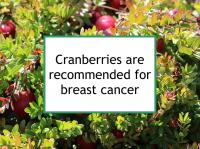Cranberries (Vaccinium macrocarpon) have relatively high antioxidant content and have been shown to have anti-inflammatory, antibiotic, neuroprotective, cardioprotective and cholesterol-lowering properties. Cranberries are an excellent source of resveratrol and a very good source of myricetin, quercetin, salicylic acid, and ursolic acid.
Cranberries are also a dietary source of delphinidin, enterolactone, fiber, manganese and vitamin C. Cranberry extracts have been shown to inhibit the growth and proliferation of brain, skin, lung, gastric, colon, and prostate cancer.
Breast cancer-related effects of eating cranberries
Berry consumption is associated with reduced breast cancer risk. Cranberries are a source of a variety of compounds with anti-cancer activities, including micronutrients that have been shown to increase the beneficial effects of breast cancer treatment.
Animal studies
Cranberries have been shown to have antiproliferative activity and to induce apoptosis (programmed cell death) in cell and animal studies. For example, feeding cranberry presscake (the material remaining after squeezing juice from the berries) to mice bearing human breast cancer cells reduced the growth and metastasis of the tumors in one study.
Resveratrol
Cranberries are also a very good source of resveratrol, which has been shown to increase the cytotoxic effects of radiotherapy and the chemotherapy drugs doxorubicin and paclitaxel against breast cancer. Resveratrol has also been reported to potentiate tamoxifen treatment and to inhibit aromatase (the synthesis of estrogen from androgens within the body), thereby strengthening the treatment effects of aromatase inhibitors.
Resveratrol has also been reported to inhibit lung metastasis in a mouse model of triple negative (ER-/PR-/HER2-) breast cancer. In addition, resveratrol has been demonstrated to help protect against cisplatin-induced ovarian and uterine damage.
Myricetin
Myricetin has been shown to trigger apoptosis in ER+/PR+, triple negative and HER2+ breast cancer cells. Myricetin has also been reported to inhibit triple negative breast cancer cell migration, invasion, and adhesion and also to reduce tumor growth and metastasis in a mouse model of triple negative breast cancer. In addition, myricetin has been found to interfere with tumor cell immortality by preventing telomere extension.
Myricetin has also been shown to increase the oral bioavailability of docetaxel in rats and to enhance the cytotoxic treatment effects of paclitaxel in ovarian cancer cells. In addition, myricetin has been demonstrated to inhibit cisplatin-induced nephrotoxicity in ER+/PR+ breast cancer cells and to reduce heart damage (cardiomyopathy) induced by doxorubicin in an animal model of chemotherapy.
Quercetin
Cranberry flavonol quercetin has been shown to increase the effectiveness of both doxorubicin and paclitaxel chemotherapy in multidrug resistant ER+/PR+ breast cancer cells, in part by eliminating cancer stem cells. In addition, quercetin has been reported to increase the sensitivity of ER+/PR+ cells to 5-fluorouracil (5-FU), thereby increasing its treatment effects. Quercetin has also been shown to enhance the anti-tumor activity of cisplatin while reducing it's adverse side effects.
Quercetin has also been found to inhibit the migration and adhesion of triple negative breast cancer cells and to significantly inhibit tumor progression in a mouse model of triple negative breast cancer. Quercetin has also been reported to inhibit aromatase, thereby supporting anti-estrogen treatment. Finally, quercetin also acts as an iron chelator, which can help reduce iron's breast cancer-promoting effects in some women.
Ursolic acid
Ursolic acid has also been shown to reverse multidrug resistance in breast cancer cells. One study found that ursolic acid reversed resistance to paclitaxel in paclitaxel-resistant triple negative breast cancer. Another study reported that ursolic acid resensitized multidrug resistant ER+/PR+ breast cancer cells to . Still another 2021 study demonstrated that ursolic acid also increased the sensitivity of triple negative breast cancer cells to .
Additional comments
Lingonberries (Vaccinium vitis-idaea) are a relative of cranberries and also have powerful chemopreventive properties.
Cranberry juice and dried cranberries
Raw fresh cranberries are too sour to be palatable for most people. Cranberry juice and dried cranberries share the overall profile of fresh cranberries. However, the processing and packaging involved in producing these foods degrades the cranberry micronutrient content. The typical addition of a great deal of sugar in these products is also unfavorable.
Using fresh or frozen cranberries in cooking or baking (for example, by adding to whole grain cereal or to home-made whole grain bread) is the best solution. This minimizes the degree of processing of the cranberries and allows you to control the amount of sugar or other sweetener used. The second best cranberry choice is low-sugar organic dried cranberries. Cranberry juice is the least favorable option, but still a better choice than commercial apple juice or most other sweetened beverages.
Sources of information provided in this webpage
The information above, which is updated continually as new research becomes available, has been developed based solely on the results of academic studies. Clicking on any of the underlined terms will take you to its tag or webpage, which contain more extensive information.
Below are links to 20 recent studies concerning this food and its components. For a more complete list, including less recent studies, please click on cranberries.
